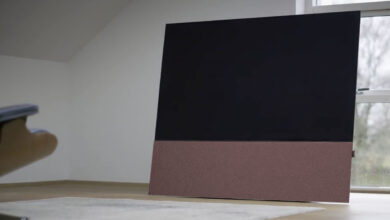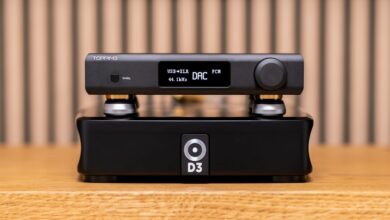
Veni, Vidi, Vici. Just look how far EverSolo has come in the audio business. They started slowly, dividing their legacy into three distinct segments: Building a name, dominating their competition, and ruling with an iron fist. EverSolo is here, and it’s here to stay. Their biggest goal was perhaps changing our preconceptions that Made in China could still be identified with world-class quality and service, slowly establishing a name for themselves.
When EverSolo released their DMP-A6 do-it-all wunderbar around two years ago, streaming junkies around the globe started humming the same song, as finally a feature-packed streamer and fully balanced DAC, rocking a plethora of digital outputs (just in case you needed to use a third-party DAC), all controlled via a modern smartphone app could be had for under one-kilo buck. It didn’t prove popular and fundamental to EverSolo’s ability to establish a foothold in the audio market; simply put, it reached a legendary status, being the most sought-after unit everybody dreamed about in 2023. Feature-packed to its teeth with little to no competition, the DMP-A6 was the first product that got our full attention. It instantly became a hit, ringing a bell that streaming music is becoming the next best thing.
Next year, an updated DMP-A8 saw the light of the day, rocking brand new DAC chips, a much beefier power supply implementation, an R2R volume control, an actual line-amplifier circuit, an extra digital output, meaner looks, and a more serious case design, already fighting with upper-class streamers with its $1980 asking price.
It was better in every possible way, and that’s when EverSolo brought the second wave: Domination of the streaming audio market. It smelled bad attitude from afar, and for more than a year, people never bothered looking for an update, as some of the latest tech could still be found inside. The firmware updates were still dropping at least once in two months, and the app support was still better than ever.
EverSolo started sending cryptic messages once again a few months ago, as a DMP-10 hashtag appeared in several posts on their social media platforms, including some juicy pictures. It was obvious that a next-generation DMP-10 could be felt in the air. A few weeks passed, and the new member of the DMP family appeared online. DMP-10 was brought to the surface as the new top-of-the-line do-it-all HiFi streamer, digital transport, music server, DAC, and preamp. We are looking at their beefiest unit, which once again brought forward massive upgrades in both digital and analog domains. A top-of-the-line ESS Sabre converter could be spotted with best-in-class oven-controlled femtosecond clocks, a beefier output stage, a better preamp stage, and a much nicer-looking enclosure that’s more stylish and refined all across the board. The best part? The price wasn’t tripled, as everybody expected; instead, it jumped from $1980 on the DMP-A8 to $3999 on the DMP-A10. As usual, I’ll be approaching it as a critic, but also as a music lover, commenting on everything I find interesting to share with you. Until that happens, let’s have a closer look at the unit.

Design & Build Quality
I must confess that the pictures you see online don’t do justice to the fit and finish of the unit. First things first, the sheer size of the unit dwarfs most streamers I tried in the comfort of my home, except for the Rockna Wavedream NET that’s even bigger and meaner. The DMP-A8 already had a substantial footprint and looked more like a traditional HiFi component, but the DMP-A10 is even more generously sized.
Instead of choosing to go with a brick-like rectangular shape, EverSolo added some diamond-like accents, around the corners and the volume knob boasts a similar design language, highlighting the product placement in the DMP lineup. This is their crown jewel, and the craftsmanship feels beyond reproach. Of course we are dealing with a CNC-machined aluminum unit, having some clever design choices that not only make it cool after a day of non-stop use but also classy and refined. Forget the WAF factor; this one wants to be touched and swiped, and it begs for your attention with its massive 6.5” HD touchscreen.

So far, this is the biggest LCD screen I’ve seen on a streamer and DAC, offering a stunning first impression. It seems to use an IPS panel, having great viewing angles and a decent contrast ratio, but please don’t expect inky blacks of OLED panels, as that isn’t going to happen. Its UI is complex but intuitive, it even has a dedicated control app for iOS and Android devices, which can work as a remote for the unit.
Its volume knob has a few tricks under its sleeve, rocking a colorful rounded display. You can program it to display the volume level, the album art, or the clock. You can increase or decrease its brightness or turn it off completely, something that I haven’t experienced as of yet.

The diamond-shaped pattern around its corners hides aluminum heatsinks that cool down the unit and ensure a long service life. I tried overloading it with tasks, letting it work as a streamer, DAC, and preamp, but no matter how hard I tried to overburden it, the temperature never went higher than 40 degrees Celsius at the hottest point, suggesting that you can use it even in much hotter places. However, decent ventilation is still needed, and some proper spacing all around.
The unit is built at high standards, having thick aluminum plates and the same matte black paint that everybody is accustomed to. It also uses four massive metallic feet with rubber pads that will absorb micro-vibrations coming from within. Its volume knob offers a pleasant physical resistance and since it’s an R2R volume control, you can hear the analog relays clicking when adjusting the volume that aren’t that loud or annoying. This is a stepped volume control that can work in 0.5 or 1dB steps. Instead of using a single wireless antenna found on most HiFi devices, EverSolo upped their game and added two additional antennas, which will cover a much wider area without losing the signal. My Gold Note DS-10 Plus was sometimes losing the signal in the living room, something that never happened with the triple antenna setup of the DMP-A10.
I don’t see a single screw all around, making it simple, yet elegant looking from any angle you’re looking at it. At 7.2 kilos (~16 lbs.), it’s on the heavier side, adding confidence that I’m dealing with a high-quality product. At 430 x 310 x 117 mm, it is bigger than most all-in-one units I tested around here. Last but certainly not least, we have a metallic remote control that will make a Cupertino designer blush with envy. It’s incredibly slim, small, and easy to hold. All of the buttons are functional, and overall, this is a high-quality remote control.
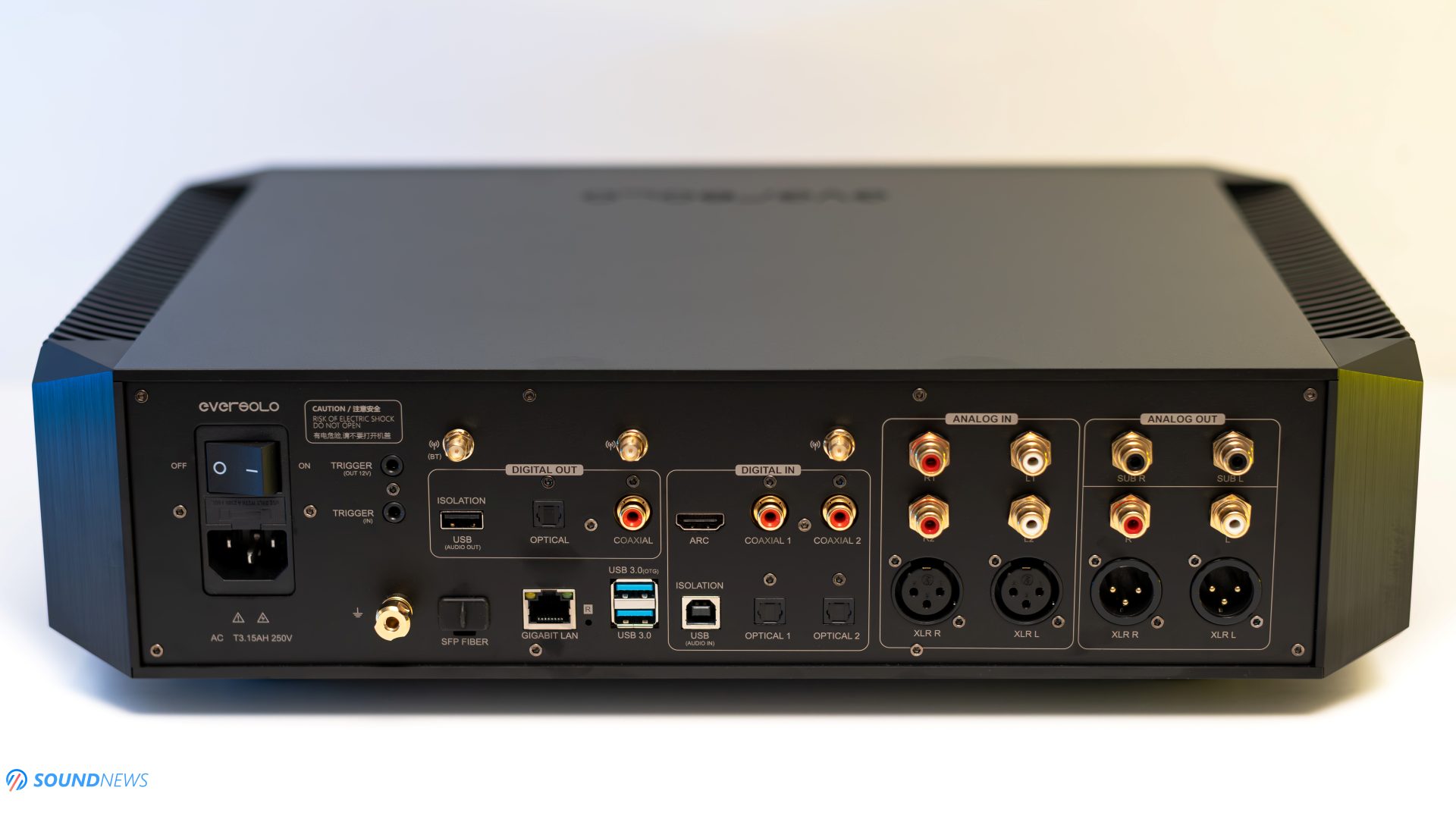
Controls & Connectivity
DMP-A10 is very easy to use thanks to a massive touch screen located in the middle, a volume knob on the right, and a single On/Off button on the left. It looks symmetrical, clean, simple, and easy to understand. What else would you need?
Having a glimpse on the back panel, it will take you some time to digest everything you see. Just look at that outstanding connectivity! In terms of digital inputs, there’s a Gigabit Ethernet port, an SFP optical fiber port, a single USB type-B port that unlocks its USB DAC feature, a pair of Coaxial and Optical inputs, and an HDMI ARC input for the cinephile in you. We have two USB Type-A ports, one used to connect third-party DACs and one for storage expansion. There’s an extra isolated USB port (recommended to be used with third-party DACs), plus an Optical and Coaxial output in case you want to use it as a streamer. Unfortunately, the I2S output (present on the DMP-A8) is no longer an option; this time around, the isolated USB type-A port seems to be your best option. We have three antennas that are working as wireless boosters, one for Bluetooth and two for Wi-Fi, and on the far right you can spot a pair of RCA and XLR outputs, including two subwoofer outputs. A mirrored symmetry of analog inputs is also there, just in case you want to use it as a dedicated preamplifier.
On its bottom plate, you’ll find two M.2 SSD slots. You no longer need a screwdriver to open the door; unscrew it gently with your thumbs for convenient M.2 SSD installation without disassembling the unit. It supports NVMe 2280 type SSDs of up to 8 TB in size. If your music collection is bigger than that, you can always add a USB flash or SSD drive via the USB OTG port found on its back.
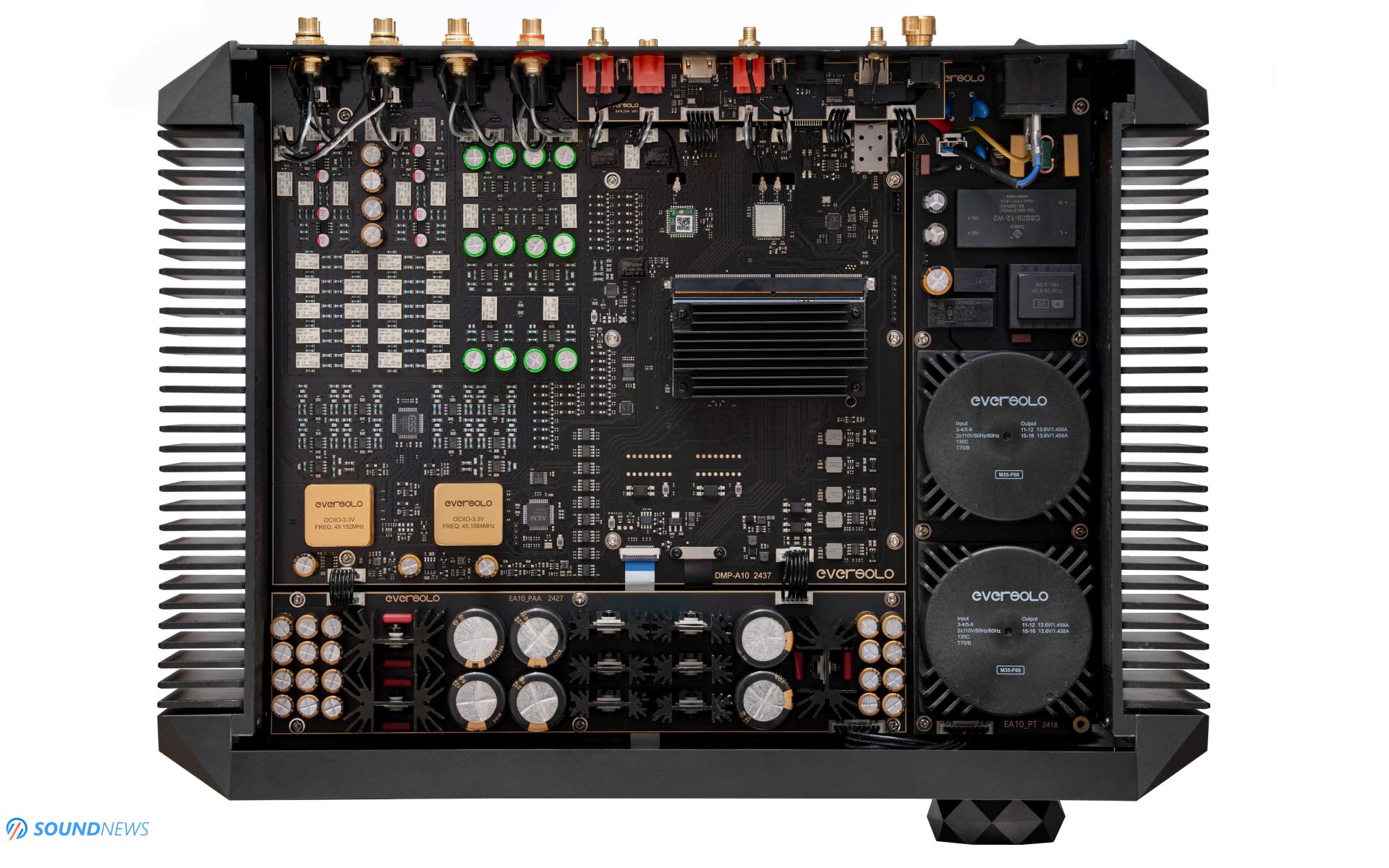
Under the Hood of DMP-A10
If you ever felt that the DMP-A8 looks overengineered and kind of impressive on the inside, wait until you open up the DMP-A10’s hood. I’m one of those guys who first opens up the units that are coming for a review, and only after carefully inspecting the PCB, the traces, the signal path, and all of the components used, do I start listening to music for a couple of weeks.
The DMP-A8 already brought forward a clever dual hybrid power supply implementation, smartly combining a switching mode power supply with a linear and regulated transformer in the same chassis, reaping the advantages of both—low ripple and noise, fast transient response, and high efficiency. The switching mode power supply juiced up the digital section, while the analog circuitry gets its power from the linear and regulated toroidal transformer. This time around, we have two linear transformers that power both the analog and digital sides of the unit, getting extra help from a smaller (third) El-core transformer. An impressive filtering stage can be spotted in the lower part of the unit, having a separate PCB board. The extra capacitance is a welcome addition, including 8 voltage regulators having their own heatsinks for long service life and proper heat dissipation.
At the heart of its digital-to-analog conversion, you’ll find a flagship-grade ESS 9039 PRO DAC chip teaming up with the XMOS 316 digital receiver that unlocks native playback of DSD512 and PCM 768 kHz at 32 bits material via USB. EverSolo stepped up the game by integrating the HyperStream IV architecture that enhanced signal processing while reducing distortion and noise for a purer sound output.
The DMP-A8 already had some decent Accusilicon 318 dual femtosecond clocks, but the DMP-A10 is now rocking dual oven-controlled crystal oscillators (or OCXOs) that offer much more stable timing, operating at a constant temperature and thus eliminating frequency fluctuations. With the jitter (noise) levels sitting below 50 fs, the sound output is now clearer than ever, unearthing additional nuance and detail from every track.

The current-to-voltage conversion (I/V) and analog output stage consists of dual op-amps and tons of discrete components, including resistors and diodes, culminating with OMRON relays. This isn’t your typical op-amp-based output stage; it’s more of a hybrid one.
The flagship QCC5125 Qualcomm Bluetooth receiver is also onboard and it supports an array of codecs and operates with wireless boosters, offering an expansive operating range that covers more than enough space in a four-room apartment.
The DMP-A10 boasts a fully balanced line amplifier (preamplifier) through RCA and XLR inputs. It provides 10 dB of analog gain, ensuring low distortion and impeccable channel balance when combined with the R2R volume control.
It uses a 4-way, fully differential, and fully balanced R2R volume control that effectively suppresses distortion and noise in the analog domain. Additionally, it features a wired and wireless streamer that can utilize the internal DAC section or third-party DACs connected via the USB-A port, Optical or Coaxial outputs. Supporting Tidal, Qobuz, Deezer, Spotify, Amazon Music, and Apple Music, this streamer allows direct content streaming without extra settings. More services are anticipated through firmware updates, and it also supports Apple’s AirPlay, DLNA, and UPnP. The coolest features of all? It’s Roon-enabled! It can be used as a Roon endpoint together with a Roon core installed somewhere around the house, even if Roon Ready certification is still undergoing.
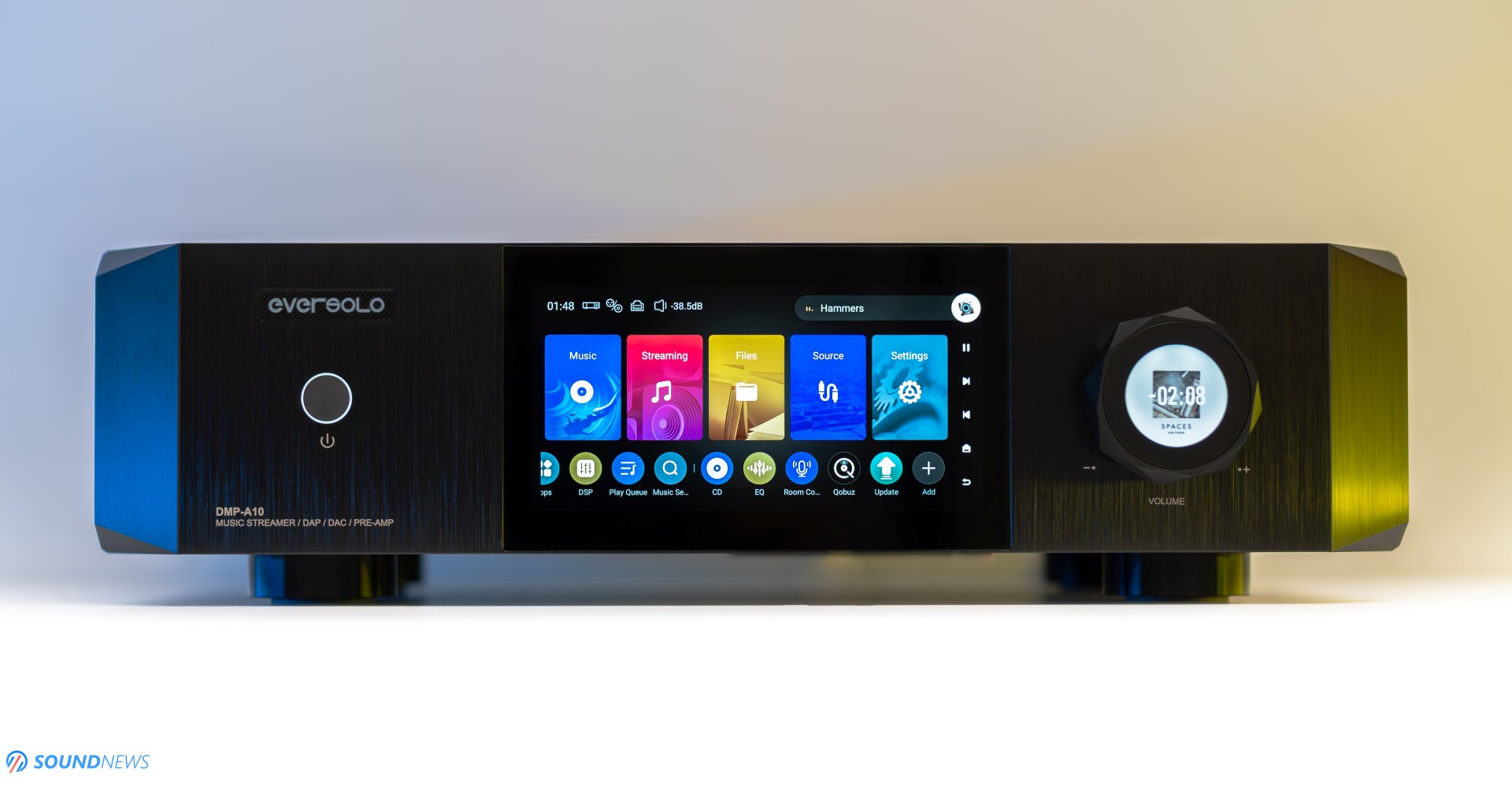
EverSolo Controller App
If you haven’t had the chance to play around with the DMP-A6 or DMP-A8, then you should know that these folks crafted their very own app that syncs with both iOS and Android devices. Absolutely every feature is at your fingertips – you can select the input and output, access your music stored on the M.2 SSD, and here’s the cherry on top: you can mirror its screen on your smartphone, automatically flipping into a landscape view. The connection between your phone and the DMP-A10 via Wi-Fi feels like a race car: snappy and lightning-fast. I had a casting option on the Shanling EM7 and FiiO S15, but when handled through Bluetooth, it had its fair share of lags and disconnects, unlike the seamless experience with EverSolo streamers. This casting option is as solid as a rock, everything moves swiftly, and you can even toss in a variety of 3rd party apps, turning it into a versatile music streamer, sans the requirement of a PC or Roon server. And if Roon is your thing, it effortlessly serves as a Roon endpoint via wired or wireless connections – just ensure you’ve got a Roon server set up first. I took the wireless and wired route, and my Roon server spotted it in a jiffy, making music streaming convenient and user-friendly.
In case you’re not keen on tinkering with Roon or third-party apps like the EverSolo Controller, you’ve got the failsafe option of Tidal Connect, which runs perfectly fine.
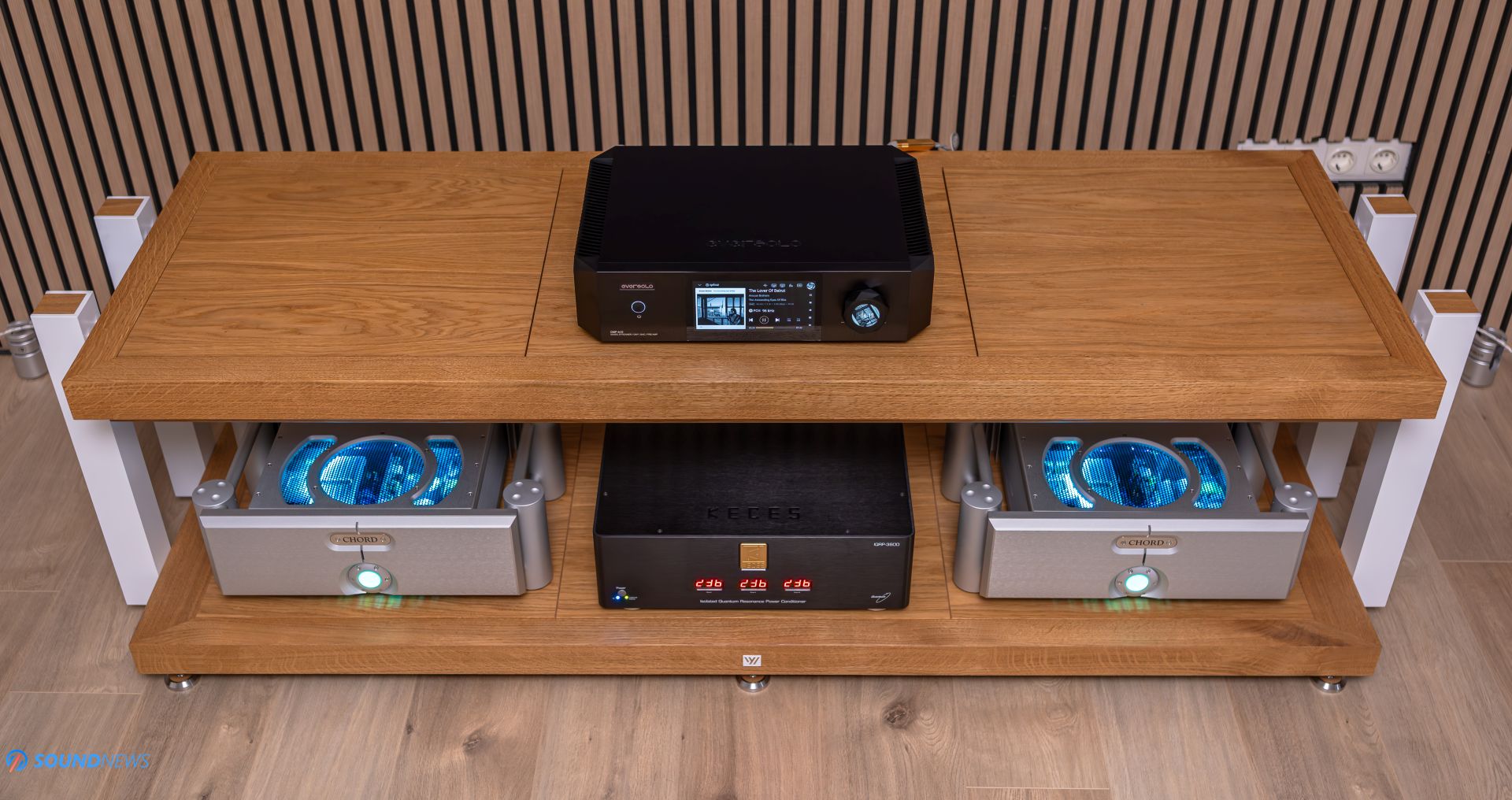
Why Invest in the EverSolo DMP-A10?
Before diving into its performance, let’s zoom out and uncover the full range of capabilities the DMP-A10 offers. In my trek through various DACs, I’ve stumbled upon pricey units that boast limited features: a few filters, a volume control (mostly an attenuator), and a remote control for volume adjustment. The DMP-A10 is a different breed.
• Functions as a smartphone with a 6.5″ screen: It houses a smartphone-like interface within the unit itself. You can tinker with third-party apps (more coming soon), all controlled through the EverSolo app or via Tidal Connect. It’s as smooth as butter – I’ve given it a hard time, and it never lagged or stuttered. A hiccup here or there required reconnecting via the EverSolo Controller app, but otherwise, it ran flawlessly for two weeks of testing.
• Versatile DAC: Not just a streaming wonder, the DMP-A10 can work as a remarkable standalone DAC. It’s more than an upgrade from the DMP-A8; it competes toe-to-toe with dedicated DACs under the ~$3000 mark. A comparison? It outperforms the Gustard X26 III and the Topping DX9, and to my ears, it sounds somewhere at the level of Gustard’s excellent X30 DAC. The sound grew on me every day and in a blind test with the X30, it will be a serious challenge picking one or the other.
• Dedicated Line Amplifier: Most DACs I tried in the comfort of my home don’t have a dedicated line amplifier circuit. DMP-A10, however, gifts you up to 10 dB of analog gain. With integrated amplifiers out of my picture, I’ve been traveling the power amp road. Witnessing a proper line amplifier in the DMP-A10? Well, that’s pure excitement. Even though I’m wielding a more expensive standalone preamp, seeing such a feature-packed unit is quite a delight.
• Streaming Prowess: It’s not just another streamer. Apart from handling proprietary apps, the DMP-A10 offers Tidal Connect and works as a Roon endpoint. While it’s still awaiting its official Roon Ready certification, it doesn’t shy away from doing the Roon endpoint job. A Roon server and additional HiFi systems? The convenience of an extra Roon endpoint is golden, consolidating favorites from Tidal, Qobuz, and offline music into one harmonious hub.
• Music Server Capabilities: Step aside, streaming—here comes the beauty of offline listening. Slot in a flash drive via the USB OTG port, add two high-capacity M.2 SSDs, and voila! Disconnect from streaming and rediscover the joy of offline music playback. Roon users, your offline tunes are also Roon-ready. All this in one package!
Even without experiencing the DMP-A10 firsthand, it’s an impressive value proposition. For anyone eyeing the future of HiFi, this is not only a fantastic starting point but quite possibly the final stop. It’s a comprehensive solution for streaming enthusiasts.
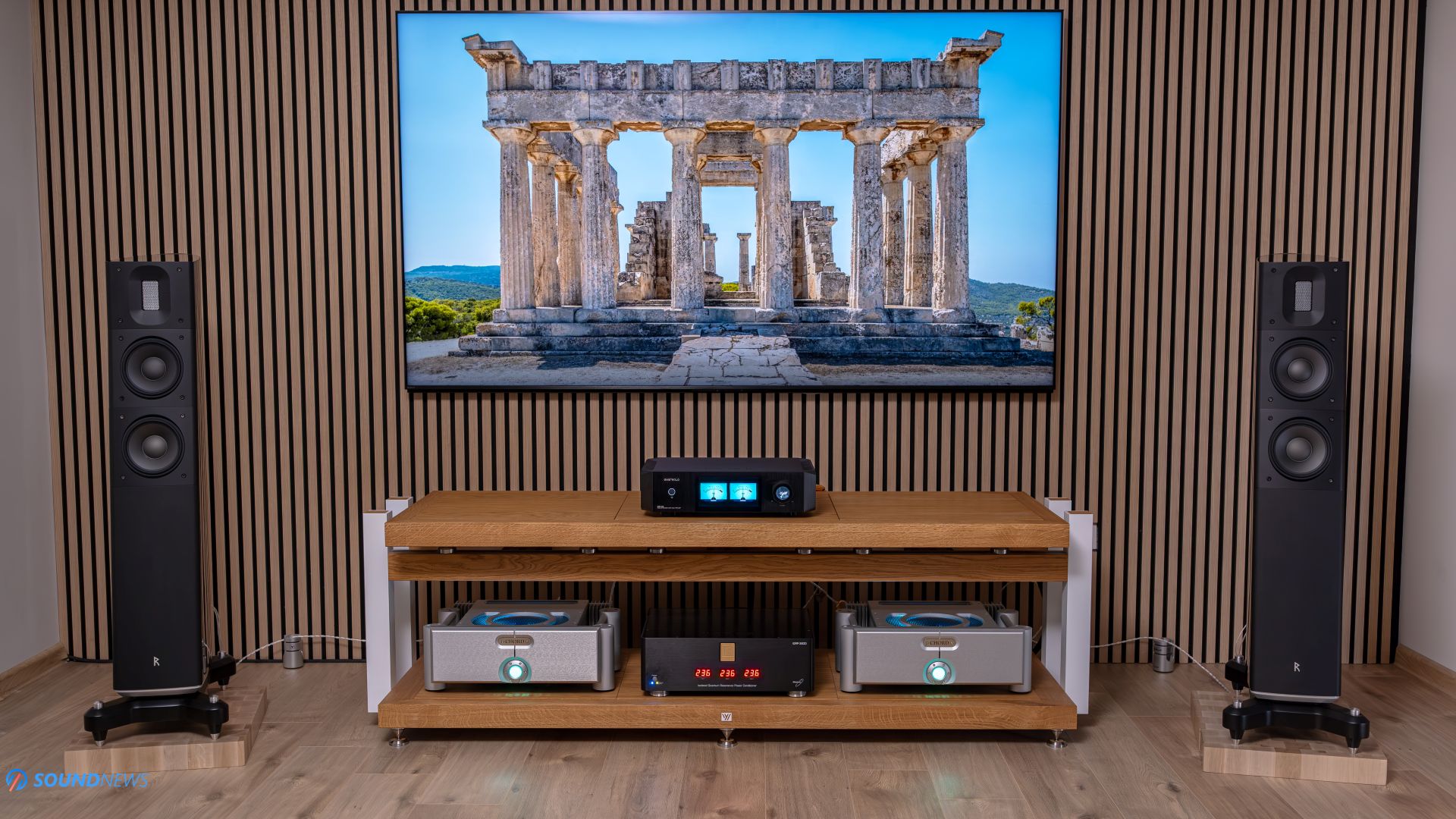
Sound Performance
I. EverSolo DMP-10 working as a streaming DAC
I was very curious about the performance of its DAC section, and this is what I tried first. I let it play as a steamer and DAC, followed by my Chord Electronics Ultima PRE2 and Ultima 3 monoblock amplifiers, driving a pair of Raidho TD 2.2 loudspeakers.
The very first thing I observed is that the infamous “ESS Sabre glare” that plagues tons of DACs using this particular chip was nowhere to be found, and it planted a seed of hope that it wouldn’t sound harsh and overly excited in the upper treble but more potent everywhere else. Frankly, this is exactly how I would summarize the sound of the DMP-A10; it impressed with a powerful kick in the lowest octaves and not so much with an overly excited upper treble. The more I listened to it, the more it reminded me about the sound of the Ferrum Wandla and Gustard X30 that had similar traits, and I believe it performs at a similar level with DACs costing around ~$3000.
The DMP-10 showed a grown-up sound that wasn’t only easy to listen to long term, it was also technical, clean, tightly controlled, and highly resolving for an all-in-one. I wasn’t gobsmacked by the resolving abilities of the DMP-A6 and DMP-A8, but the DMP-A10 is more impressive, showing additional nuances and extra details happening on the micro level.
Regardless of the music played, it was not forcing it in any way; it didn’t feel extra sharp, and the leading edges weren’t so outlined, having a more relaxed presentation compared to what they did in the past. It almost felt like I was listening to a high-end delta-sigma DAC that offers similar sonic traits. The sound was slightly weightier compared to what I found on the FiiO’s S15, which was a bit more neutral sounding by comparison. The DMP-10’s tonality felt a tad richer, especially in the bass, which added more meat on the bone. The sound was also pushed much deeper into the room, slowly expanding the soundstage in all directions. I recently reviewed the FiiO’s S15 streamer, and while I was impressed by its resolving abilities and by a more organic presentation compared to what I’ve experienced on the DMP-A6, FiiO R7, R9, and later on the Matrix Mini-i 4, sometimes it wasn’t putting me easily into a nirvana state.
By comparison, the DMP-10 is even more impressive in terms of resolution and nuance, and the difference is immediate, but this time around, there’s a slight beatifying filter applied on top that improves the contrast and the texture of the music.
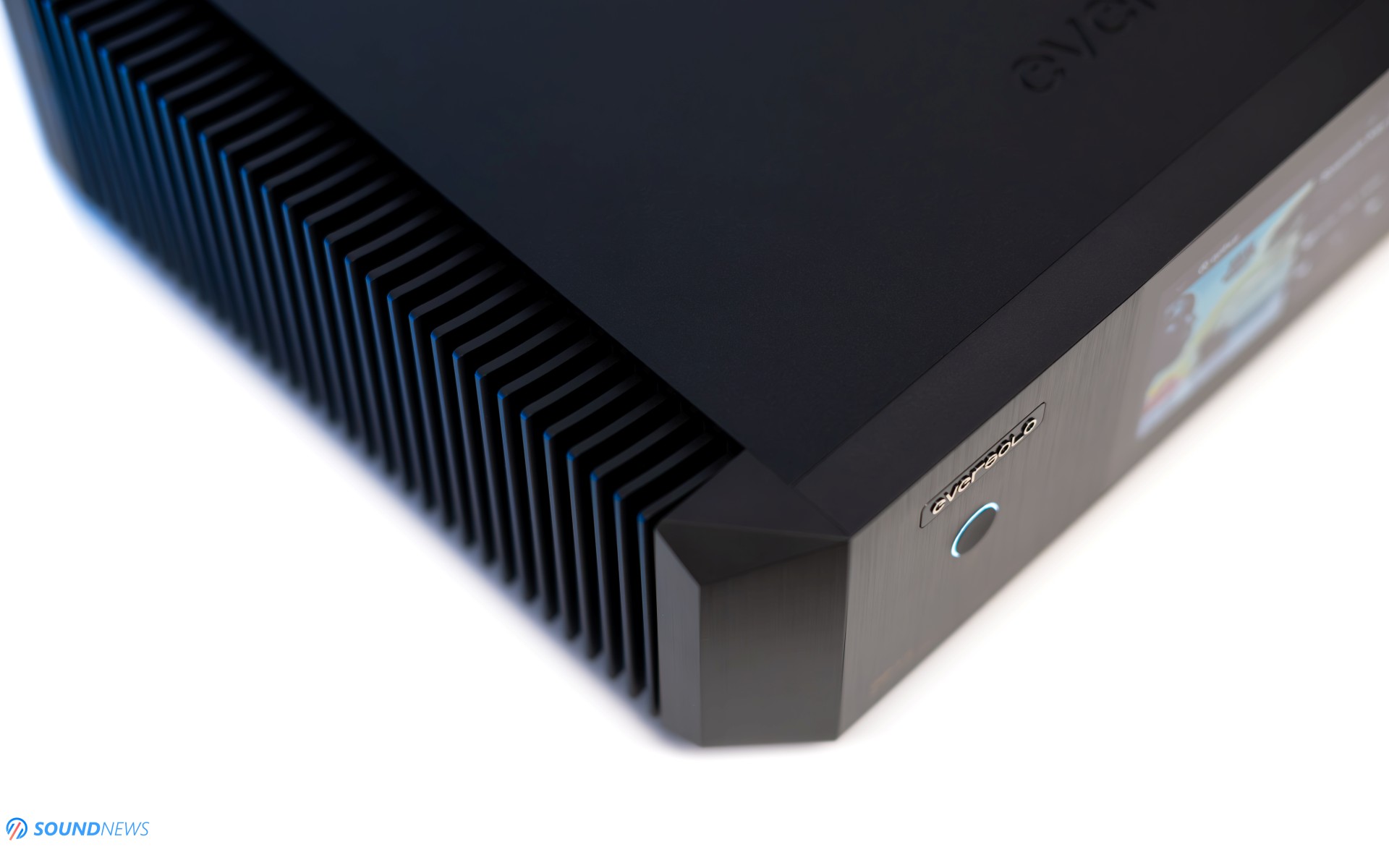
If you need a music-making machine that would add some character, remove traces of brightness, and lift the veil covering your tunes, then DMP-10 feels like one of those units. For the record, I don’t find it overly warm or syrupy; it’s mostly neutral and clean, with a hint of denser textures while offering a stronger kick in the bass, which transforms a simple listening session into a pleasing one. While punchy and quite impactful with the right tunes, I don’t find it extremely fast or overly excited in the trebles. DMP-A10 is easier going in this regard; there is enough punch and slam down low, but not as much as to call it thunderous.
The DMP-A10 does not go into the ultra-linear, dead-neutral, almost cold territory, choosing a resolving sound but without becoming boring or emotionless. It was clean and detailed sounding, and I liked that the sounds were placed all around the room, providing an impressive stereo separation. While FiiO’s S15 and EverSolo’s DMP-A8 were already playing with my imagination, pushing the sounds much farther away from me, the DMP-A10 further enhanced this effect, improving the scale of the music on all axes. The 3D effects of the Eversolo’s greatest unit are undeniable, and you’ll experience them in both a stereo rig and a head-fi battle station.
It was nicely expanding or shrinking the stage depending on the music being played and it had all the signs a well-made HiFi DAC should have. Unsurprisingly, it also had a nice control over my speakers, having a better grip versus the DMP-A8 which had longer trails and decays. If the tonal density is something that you deeply care about, then DMP-10 shares a similar sound signature with the Ferrum Wandla and Gustard X30, putting a mild accent on the bass delivery, getting a fun and engaging sound at the end of the day. It didn’t lack body or emotions in the midrange, but don’t expect a creamy, juicy, or warm sounding midrange, as that isn’t going to happen.
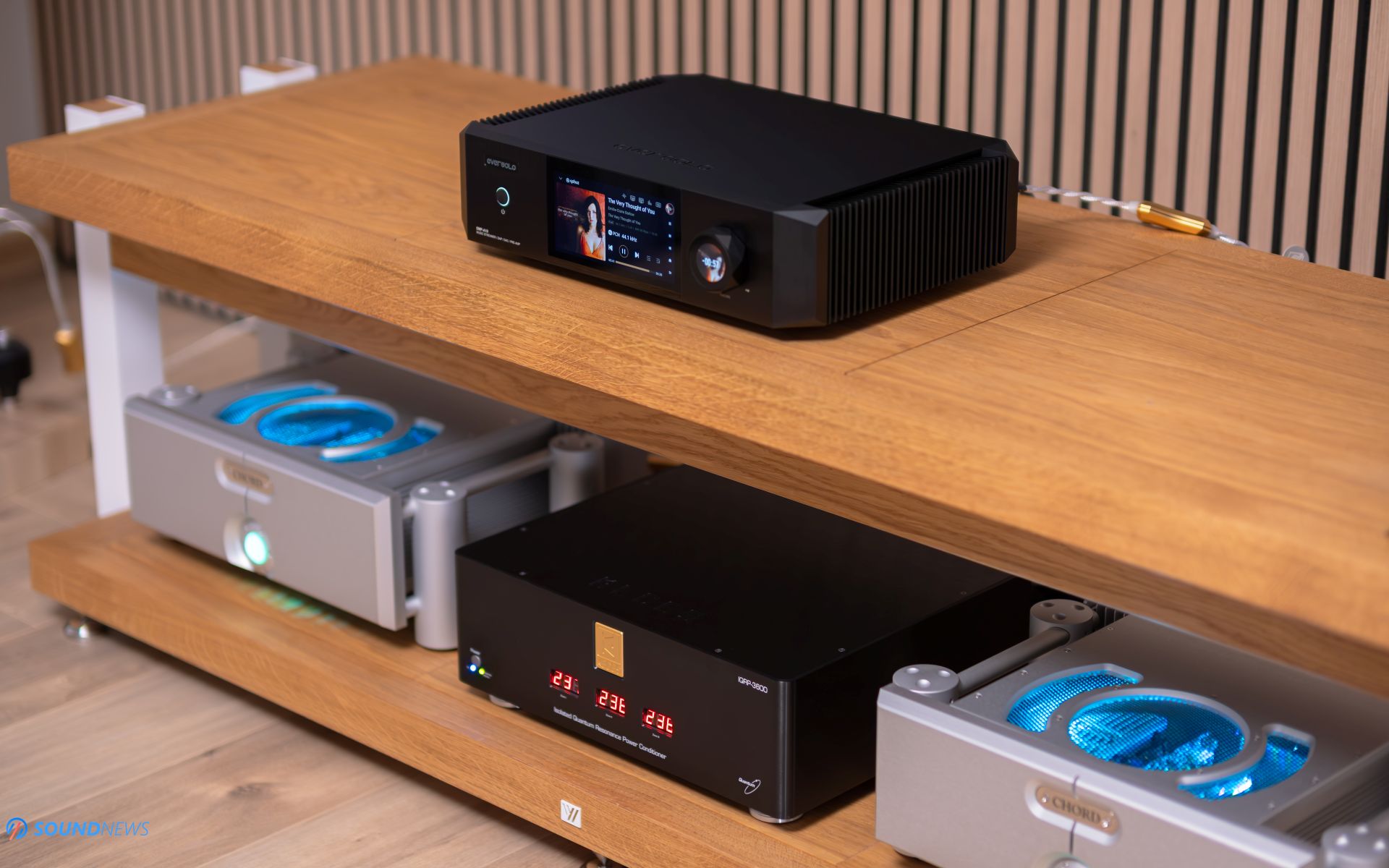
II. EverSolo DMP-10 working as a streaming DAC & Preamplifier
On the next day, I decided to completely remove the Rockna Wavedream NET Roon server, the Rockna Reference Signature DAC, and the Chord Electronics PRE2 and let the Eversolo work as a 3-in-1 device. My expectations weren’t low, as I’m still dealing with a flagship all-in-one, but at the back of my mind, I knew that it wouldn’t outperform the state-of-the-art separates that I’m using daily.
I have already explored its streaming DAC performance, and it does perform like a well-made delta-sigma DAC, but what about its active preamp stage?
First of all, the word “active” means a lot to me, and it should mean something to you, too. Most D/A converters use a passive preamp or an overly simplified digital attenuator (volume control) that loses bits of information the moment you start lowering the signal intensity (the volume). 99% of the DACs I tested around here had a digital attenuator/volume control, only a small portion of them used an analog volume control, and even a smaller portion were blessed with active preamplifier sections. The DMP-A10 has them both! An analog volume control using tens of resistors (R2R volume control) AND an active preamplifier stage, and this, my friends, is a very big deal! You will no longer need a separate active preamplifier that might cost an arm and a leg; the only thing you need is a power amp or two (monoblocks), and that’s exactly what I’m going to use. EverSolo developed their own power amp, the AMP-F10, specifically designed to be the best pal for the DMP-A10. You can pick a single AMP-F10 or two for some dual-mono action.
Letting it play as a 3-in-1 unit made me realize how much cooler the DMP-10 is in a simple living room, where WAF is a very important factor in your family life. Two metallic boxes are all you need to start listening to music at pretty high levels (for the record, I use 7 metallic boxes to do all of the heavy lifting).
At the end of the day, an active preamplifier does more than just control the music (which would be the realm of a passive preamplifier); it contains active components in the circuit that can be buffered into a Class-AB or, even better, a Class-A design and reveal a level of refinement and flow that was previously absent. I firmly believe that the preamplifier serves not only as the conductor of your HiFi system, controlling every note with an iron grip, but also acts as both the composer and the soloist, allowing emotions to invade your listening environment and reveal the beauty within.

After removing the Chord’s PRE2, I prepared a refreshment, closed my eyes, and crossed my fingers for good luck. I hoped the stage wouldn’t collapse on me, a fate I’d experienced way too many times before. After listening for three uninterrupted hours, I realized that it was not playing on the same level as the massive soundscape oozing from the PRE2, nor did it bring the most natural sound I ever experienced through a preamplifier. Although the DMP-A10 wasn’t quite as tight and lightning-fast as the PRE2 with modern tunes, it delivered a natural sound signature, and the soundscape didn’t shrink that much. Some sweetness was still propelled forward, siphoning away any listening fatigue; I was so immersed in the sound that I became one with the sofa I was sitting on. The sound wasn’t abrasive; brightness never raised its ugly face, receiving in return a highly entertaining experience that infused a bit more life into the bass versus any other frequency range. The sound was ever so slightly mid-bass centric, getting plenty of oomph and fullness at the end of the day.
I was listening to Paradis Perdus by Christine and the Queens (found on Qobuz and Tidal), and even from the first notes, the bass notes were tightly controlled but strong and present in every corner of the room. The stereo separation was quite impressive, and even if tens of notes per second were playing mid-track, everything played in a distinct air bubble, never interplaying with the next note. The sound wasn’t only smooth and quite organic but also 3D and airy, highlighting the quality of the recording.
The more music I added to my playlist, the clearer it became that the DMP-A10 was meant to be savored not only as a streaming DAC but also as a preamplifier. In all honesty, I’ve been listening to my stereo significantly more lately and I enjoyed the sound of the DMP-A10 a bit more as an all-in-one. At no point did I feel that it negatively affecting the signal or that the monoblock amplifiers weren’t receiving a robust signal. The only advantage the pricier Ultima PRE2 had over the DMP-A10 was its additional gain settings (0.5, 1.0, 1.5, and 2.0 gain options), a much wider selection of analog inputs, and, of course, better sonics if the rest of your system is up to the task.

III. EverSolo DMP-10 working as a standalone HiFi streamer
On the third day, I wanted to try out its streaming capabilities…working just as a streamer and nothing else, adding a Rockna Reference Signature DAC via the isolated USB Type-A port, followed by my Ultima PRE2 and Ultima 3 monoblocks and firing up my wacky playlist one last time.
I decided to bypass my Roon Server and let it play just as a streamer with its casting function which is so convenient to use. If you don’t want to interact with the EverSolo app, feel free to use Tidal Connect, which worked flawlessly in my case. Since the streamer can have a major impact on the DAC that follows, I was prepared for anything.
Terminal 7 by Tomasz Stanko (found on Tidal and Qobuz) started playing – an experimental psychedelic chillout, mixing funk, tons of acoustic instruments, and lots of percussion work. Although this seems like a simple track, the bass lines rising in intensity and then fading away slowly always keep you awake. This track is all about stereo separation, depth, and holography. Around mid-track, this is no longer the simple track you expected. The sounds aren’t just interplaying with each other, but there’s a clear and defined distance between them and your listening spot. On some not-so-impressive streamers, the layering never felt this strong, nor the note separation, let alone the naturalness and flow of the music that I’m experiencing via the DMP-A10. The ability to portray a big picture is preserved for high-end streamers that rock an over-engineered power supply. Although I’m not describing a 20-kilo unit, EverSolo’s best removed the cloudiness and let me focus on things playing in the background. I could see a clear picture of where everything was located in the living room. The layering was great; there was enough void space in between the notes, the sound extended above the borders of the living room, and all the beats were loud and clear. Even the most crowded passages weren’t exactly…crowded, never overlapping the notes on top of each other.
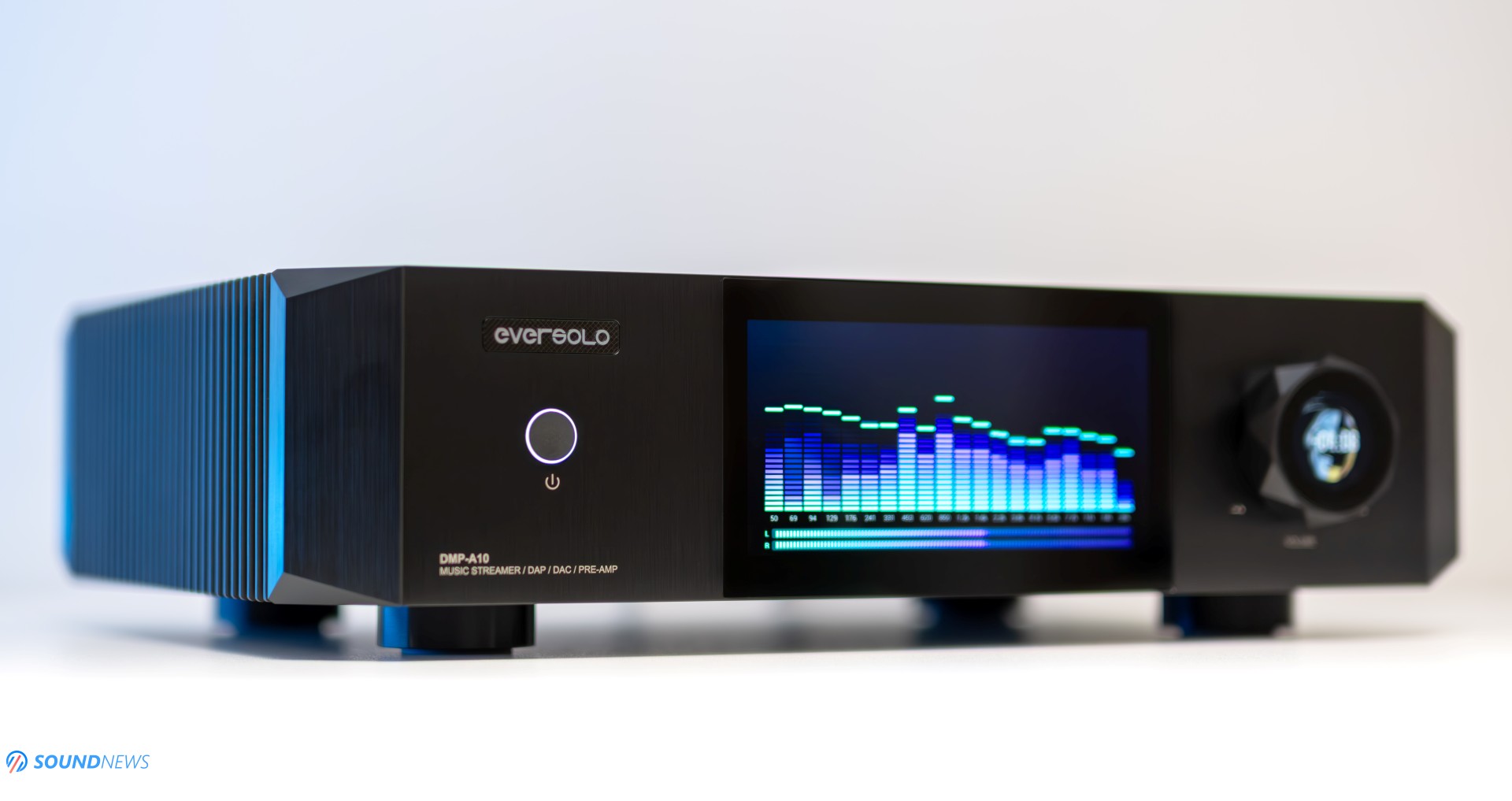
A couple of moments later, Dan Patlansky starts his prayer in Hallelujah (found on Qobuz and Tidal). While I’m not so fond of Patlansky’s slow guitar solos that lack the speed and technical prowess of Marcin Patrzałek, there’s something about his guttural voice that always begs to add an extra track on the playlist. The vibration of the vocal cords is as difficult to render as the vibration of piano notes. I have heard this track tens of times by now, and only rarely can I say that Dan’s voice is blooming with nuance and intricacy. The DMP-A10 was able to show a lower pitch without lowering the intensity of his voice. Dan’s inner voice was loud, textured, and crystal clear, and I don’t remember getting a similar performance from another streamer.
I still don’t consider removing the Wavedream NET from my system, but there’s definitely lots of sex appeal with the EverSolo, not only in a stereo rig but also in a head-fi battle station. It was more than good enough for my setup, and I’m sure it would be more than enough for yours.

IV. Nitpicks
Let’s talk about the nitpicks I found with this unit. The first nitpick that can be a major downgrade for some of you is that we no longer have an I2S output present on the cheaper DMP-A8. For those who don’t know, I2S is considered the best connection between a digital transport and a DAC for a couple of reasons. I2S has separate lanes for data and clock transmission, and let’s not forget that we don’t have a digital receiver on the DAC end via I2S, bypassing a chip and an extra conversion. Plus, the I2S bandwidth is almost unlimited compared to, say, S/PDIF. My former Rockna Wavedream Signature worked best via I2S, the Gustard X30 and R26 also sounded best via I2S, and a much older Matrix Element X DAC also worked best via I2S. You get my point.
My second nitpick is that for a proper Room Correction, a feature I looked forward to testing out rigorously, you’ll need to buy separately the EverSolo EM-01 microphone. It’s an omnidirectional mic that’s compatible with both iOS and Android devices, an ideal choice for DIRAC and RAW software. You can do a less precise Room Correction with your smartphone’s microphone, but don’t expect it to perform at the level of EM-01. This particular microphone will cost you an extra $69, and I wish it was bundled with the DMP-A10 for a no-compromise Room Correction.

Wrapping Up
I wish I could include several comparisons to conclude this review in the usual fashion. Alas, the FiiO S15 and the EverSolo DMP-A8 don’t perform at a similar level, nor do they offer the same feature set.
All in all, EverSolo’s DMP-10 seems like a fantastic all-in-one with little to no compromises. The DAC section performs similarly with dedicated DACs costing around ~$3K. I found it highly technical, resolving and transparent sounding and let’s not forget the impressive holography and stereo separation it brought forward with every tune.
Its active preamplifier section was another pleasant surprise, ranking one notch below the KECES S4 and two notches below my Chord Electronics Ultima PRE2. Just add a power amp or two and a pair of passive loudspeakers that sound to your liking, and you’ll be knocking at heaven’s door in no time.
And let’s not forget how impressive the DMP-A10 can get when working as a standalone streamer and/or Roon endpoint. The HiFi Streamer section is as important as the DAC section; it’s the inception point of your HiFi system, and it needs to perform at a very high level. In two weeks, it always delivered clean and noiseless sonics, while not changing the DAC’s character connected to it.
Having tested multi-featured products for a while now, I’ve learned a few key lessons: As a HiFi manufacturer, you often lack the budget, time, or expertise to make all features equally impressive. For instance, if you have a DAC with preamp capabilities, it’s usually a great DAC that is paired with a mediocre-at-best passive preamplifier. Similarly, when a DAC includes a streamer, one feature often outshines the other, and I have countless examples to give. Great sounding 3-in-1 units don’t exi…..they do exist now! Except for two nitpicks, the EverSolo DMP-A10 has all the features I need, it’s a great-sounding unit, and it’s my pleasure to recommend it. Our Highly Impressive award feels like a perfect fit, and I’m looking forward to their next developments.
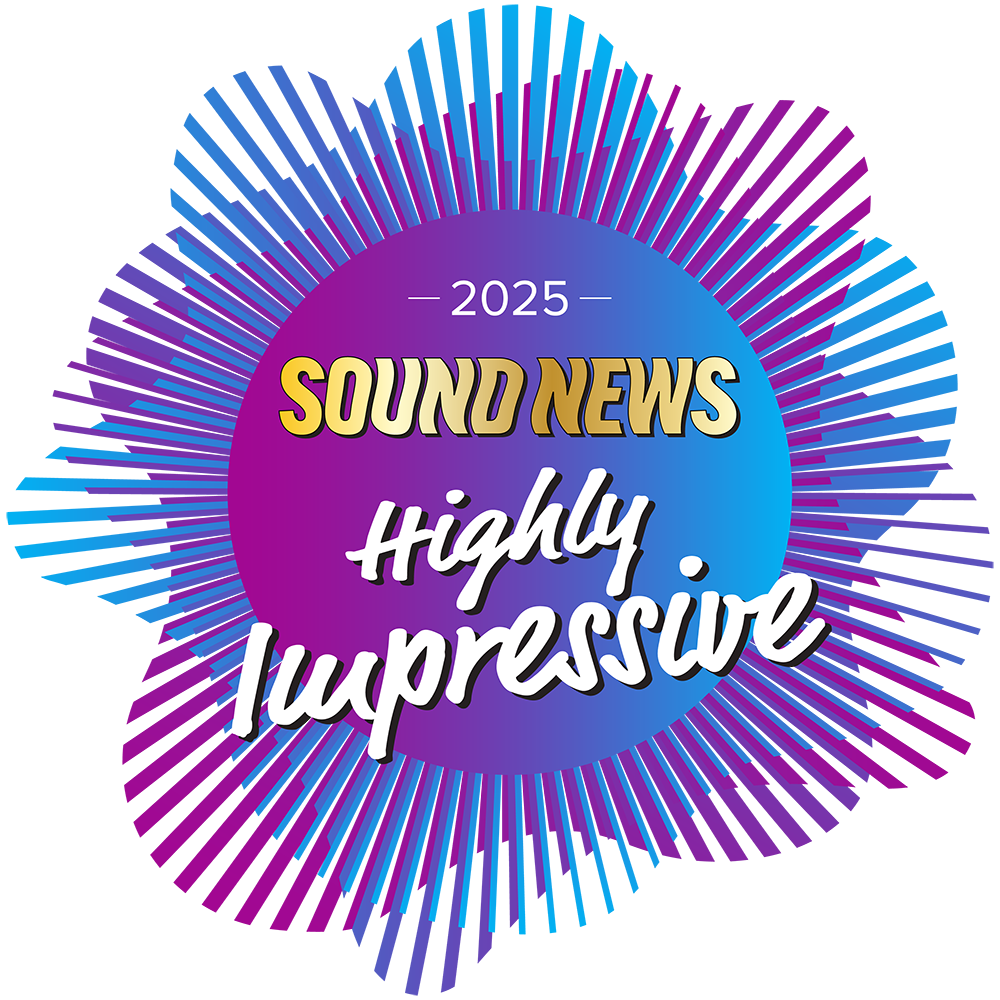
If you take the plunge and still have some burning questions, feel free to drop a line in the comments section below. That’s all for now – Sandu signing off!
PROS:
- Beautiful inside and out, with great fit & finish.
- Simple & minimalist & future-fi
- Great looking remote control, built to high standards
- Excellent connectivity and I/O options
- Impressive component selection and power supply implementation down to the smallest details
- OCXO atomic clocks & complete electrical isolation make it technical yet noiseless
- This is the most feature-packed all-in-one unit I have tried as of yet! There isn’t a function that DMP-A10 doesn’t have already
- Clean and highly resolving DAC section that’s on par with high-performance dedicated DACs
- We’re dealing with an ESS-Sabre implementation, yet it provides an outstanding tone & timbre
- Having an active preamplifier section feels like the cherry on top
- Great stereo separation, depth, and holography, one of the best we’ve experienced so far
- Sounds fun and technical at the same time
- Although pricey, I still consider it a bargain
CONS:
- An omnidirectional microphone isn’t included in the package for a proper Room Correction
- The I2S port is no longer present
- Roon Ready certification isn’t ready yet
ASSOCIATED EQUIPMENT:
- Digital Transport / Roon Server: Rockna Wavedream NET 4 Tb, EverSolo DMP-A10
- Network Switch: Ansuz PowerSwitch D3
- DACs: Rockna Wavedream Reference Signature & EverSolo DMP-A10
- Headphone Amplifiers: Cayin Soul 170HA, Feliks Envy Performance Edition
- Preamplifier: Chord Electronics Ultima PRE 2
- Power Amplifiers: Chord Electronics Ultima 3 (X2)
- Full-sized headphones: HiFiMan Susvara Unveiled & Susvara OG, HE1000 Unveiled, T+A Solitaire P, Meze Elite, Erzetich Charybdis, Kennerton Rognir, Sennheiser HD800S & many others
- Loudspeakers: Raidho TD 2.2
- Interconnects: Crystal Cable Monet XLR (X2)
- Speaker cables: Crystal Cable Monet 2.5m
- Power Cables: Crystal Cable Monet 1.5m (X4), Neotech NEP-1001 (X2)
- Ethernet Cable: Crystal Cable Monet
- HDMI Cable: AudioQuest Dragon
- Balanced Isolation Power Conditioner: KECES IQRP-3600
- Audio Racks: Woodyard Suspended Triple & Baby Modular




